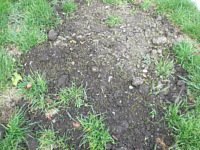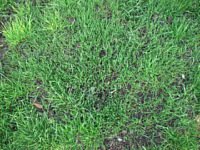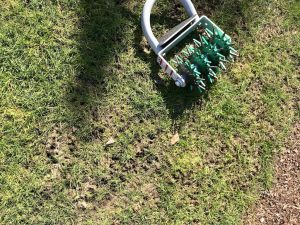Overseeding turns a thin, worn-out lawn into a thick, lush lawn. A healthy, dense lawn will choke out weeds, resist pest attacks, and endure drought.
Some of the links in this article are affiliate links. This means if you click on the link and purchase the item, I will receive an affiliate commission at no extra cost to you. All opinions remain my own. PLEASE READ MY DISCLOSURE FOR MORE INFORMATION.
It’s an important cultural practice that should be included in your lawn maintenance program, combined with aeration, even if your lawn is already thick. You should plan to overseed at least every 3 to 4 years, but, if you aerate and overseed every year, you’ll see really nice results — a lush, green lawn that fends off weeds, insects and diseases.
Some types of warm-season grasses can be kept green through the winter when they are overseeded with perennial ryegrass in the fall.
What we cover
ToggleWhy You Should Overseed Your Lawn
- Lawn Repair, fixes bare patches and fills in thin areas.
- Keeps lawns thick and weeds out.
- Introduces new grass varieties (that might grow better) making a healthier lawn.
- Rejuvenates cool season lawns after a hot, stressful summer.
- Provides green cover and protection for warm-season grasses


Summer weather, use and traffic abuse your lawn, causing thin and bare spots. Older lawns get “tired” through the years. Fall overseeding renews your lawn. Thin and bare patches fill in quickly. You’ll end up with a dense weed-free yard.
New seed varieties are constantly being developed. Overseeding adds these improved grasses to your lawn. Some of these might grow better in the shade or under trees, need less water, grow better in high-traffic (or soil-compacted) spots, or resist diseases better. Mixing diverse grass species into your lawn will improve it.
Are you growing a warm-season grass…like bermudagrass? Overseeding with perennial ryegrass will keep it green and protect it grass this winter. Golf course and sports field managers overseed to keep their playing surfaces green and protect the dormant grasses and keep winter annual weeds in check.
How to Overseed a Lawn
- Start by mowing your grass low – an inch or so lower than normal.
- Bag or rake up excess clippings.
- Add topsoil – mixed with seed – to low or bare areas.
- Aerate with core aerator going over the lawn in 3 to 4 times.
- Spread seed at recommended seeding rates (found on bag label).
- Fertilize with a slow-release nitrogen fertilizer.
- Water your new seed frequently to keep moist.
- Continue your normal mowing routine.
Overseeding Tips
Late August/September is the best time to overseed. This gives the new seed time to grow before frost. And good growing conditions in the spring to prepare for summer stresses.
If you need to spray weeds, get this done at least 14 days before seeding.
Plant grass that matches your existing lawn. When shopping for seeds, you’ll notice many bags of seeds come in blends of grass cultivars (cultivated varieties) and types. A bag of Kentucky bluegrass will have creeping red fescue and perennial ryegrass mixed together. These grasses complement each other. You don’t want to overseed tall fescue into a bluegrass lawn.
Purchase quality certified seed. Buy the cheap stuff and that’s what you’ll get — cheap seed full of inert fillers and weed seed. So get the good stuff! For a few bucks more…it’s worth it. Your success depends on making good seed-to-soil contact. Core aerating before seeding yields nice results. Grass seed finds its way into the plug holes where it is protected and moist. Be sure to run the aerator over your lawn in at least three directions – making a lot of holes.
Power raking thatch build-up and mowing low also helps prepare your lawn for seeding. A slit seeder is a good option for really thin lawns.
Spread the seed at the recommended seeding rate found on the label.
Tip: Use a drop spreader to seed the edges of landscape beds and the boundaries of your lawn. Then you can use a broadcast spreader on the rest. This keeps grass out of areas where you don’t want it growing.
Perfect tool for repairing small areas
 I’ve been using the seed stitcher for repairing small areas in existing lawns. The seed stitcher prepares an area for overseeding by punching funnel-shaped holes in the soil that are perfect for grass seed. It works through turf thatch so you don’t need to remove/rake it before seeding. Quick with great results!
I’ve been using the seed stitcher for repairing small areas in existing lawns. The seed stitcher prepares an area for overseeding by punching funnel-shaped holes in the soil that are perfect for grass seed. It works through turf thatch so you don’t need to remove/rake it before seeding. Quick with great results!
More Essential Lawn Care Practices:
How to choose the best lawn fertilizer. What do the numbers on the bag mean? Are organic fertilizers more eco-friendly than chemicals? Consider costs and nutrient needs. Are they pet-safe?
Lawn Mowing: Tips and techniques, the basics of lawn care. How to cut grass like a pro. Cutting grass to keep it looking groomed and healthy. DIY tips and advice for growing grass.
Use this fertilizer calculator to determine the amount of granular fertilizer product that is needed to spread on your lawn according to recommended rates.
